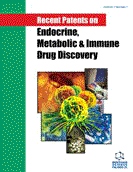Abstract
Osteoporosis diagnosis, which is nowadays generaly made based on bone mineral density (BMD) measurements, suffers from certain limitations. Thus it is believed that bone turnover markers (BTMs) can help improve osteoporosis detection. The shifting interest toward this topic made us perform a review to gather information on existing markers and their role in osteoporosis diagnosis. Based on the results, in this review, a list of existing markers and some of their characteristics is provided. Moreover, a brief explanation of different types of variability met while using these markers is also described. Finally some of the patents provided for the diagnosis of these markers are presented. While the use of BTMs in osteoporosis diagnosis has certain advantages over BMD and clinical risk assessment tools, more studies are needed before they can be used as a separate tool in this regard. It could be concluded that despite the fact that BTMs are better than BMD not only in monitoring treatment but also in identifying those at-risk, the diagnostic value of BTMs in predicting osteoporosis is low, and thus a model is needed to assess several BTMs at the same time with higher accuracy and lower variability to overcome this limitation.
Keywords: Bone, bone mineral density, bone turnover markers, osteocalcin, osteoporosis.
Recent Patents on Endocrine, Metabolic & Immune Drug Discovery (Discontinued)
Title:Biochemical Markers of Bone Turnover and their Role in Osteoporosis Diagnosis: A Narrative Review
Volume: 9 Issue: 2
Author(s): Patricia Khashayar, Hamidreza Aghaei Meybodi, Ghassem Amoabediny and Bagher Larijani
Affiliation:
Keywords: Bone, bone mineral density, bone turnover markers, osteocalcin, osteoporosis.
Abstract: Osteoporosis diagnosis, which is nowadays generaly made based on bone mineral density (BMD) measurements, suffers from certain limitations. Thus it is believed that bone turnover markers (BTMs) can help improve osteoporosis detection. The shifting interest toward this topic made us perform a review to gather information on existing markers and their role in osteoporosis diagnosis. Based on the results, in this review, a list of existing markers and some of their characteristics is provided. Moreover, a brief explanation of different types of variability met while using these markers is also described. Finally some of the patents provided for the diagnosis of these markers are presented. While the use of BTMs in osteoporosis diagnosis has certain advantages over BMD and clinical risk assessment tools, more studies are needed before they can be used as a separate tool in this regard. It could be concluded that despite the fact that BTMs are better than BMD not only in monitoring treatment but also in identifying those at-risk, the diagnostic value of BTMs in predicting osteoporosis is low, and thus a model is needed to assess several BTMs at the same time with higher accuracy and lower variability to overcome this limitation.
Export Options
About this article
Cite this article as:
Khashayar Patricia, Meybodi Aghaei Hamidreza, Amoabediny Ghassem and Larijani Bagher, Biochemical Markers of Bone Turnover and their Role in Osteoporosis Diagnosis: A Narrative Review, Recent Patents on Endocrine, Metabolic & Immune Drug Discovery (Discontinued) 2015; 9 (2) . https://dx.doi.org/10.2174/1872214809666150806105433
| DOI https://dx.doi.org/10.2174/1872214809666150806105433 |
Print ISSN 1872-2148 |
| Publisher Name Bentham Science Publisher |
Online ISSN 2212-3334 |
 41
41Related Articles
-
Non-transfusion Dependent Thalassemias: A Developing Country Perspective
Current Pediatric Reviews Recent Advances in the Treatment of Neurogenic Erectile Dysfunction
Recent Patents on CNS Drug Discovery (Discontinued) Effects of Maternal Obesity on Maternal and Fetal Health
Current Women`s Health Reviews Statins as Either Immunomodulators or Anti-Cancer Drugs: Functional Activities on Tumor Stromal Cells and Natural Killer Cells
Anti-Inflammatory & Anti-Allergy Agents in Medicinal Chemistry Jak2 and Reactive Oxygen Species: A Complex Relationship
Current Chemical Biology Inflammation, Endothelial Dysfunction and Arterial Stiffness as Therapeutic Targets in Cardiovascular Medicine
Current Pharmaceutical Design Tanshinone IIA Promotes Macrophage Cholesterol Efflux and Attenuates Atherosclerosis of apoE-/- Mice by Omentin-1/ABCA1 Pathway
Current Pharmaceutical Biotechnology Bamboo a Supplement to Human Health: A Comprehensive Review on its Ethnopharmacology, Phytochemistry, and Pharmacological Activity
The Natural Products Journal Use of Biguanides and the Risk of Colorectal Cancer: A Register-Based Cohort Study
Current Drug Safety The Changing Face of HIV/AIDS in Treated Patients
Current HIV Research Lipid Mediator Profiling in Pulmonary Disease
Current Pharmaceutical Biotechnology Targeting Metabolic Enzymes in Cancer – Clinical Trials Update
Current Enzyme Inhibition Molecular Modelling Studies on Thiazole-Based α-Glucosidase Inhibitors Using Docking and CoMFA, CoMSIA and HQSAR
Current Drug Discovery Technologies Understanding Gender Differences in Schizophrenia: A Review of the Literature
Current Psychiatry Reviews Inflammation Fueling Atrial Fibrillation Substrate: Seeking Ways to "Cool" the Heart
Medicinal Chemistry A Critical Appraisal of the Functional Evolution of P2Y12 Antagonists as Antiplatelet Drugs
Current Pharmaceutical Design Thiazoles and Thiazolidinones as Antioxidants
Current Medicinal Chemistry Coffee: A Selected Overview of Beneficial or Harmful Effects on the Cardiovascular System?
Current Vascular Pharmacology Contribution of ALDH2 Polymorphism to Alcoholism-Associated Hypertension
Recent Patents on Endocrine, Metabolic & Immune Drug Discovery (Discontinued) Insulin Resistance, Obesity and the Metabolic Syndrome. Is there a Therapeutic Role for Endothelin-1 Antagonists?
Current Vascular Pharmacology






















